The international market
Changes in the consumption of olive oil and table olives in overall consumption have been reported. Below, you can consult official data
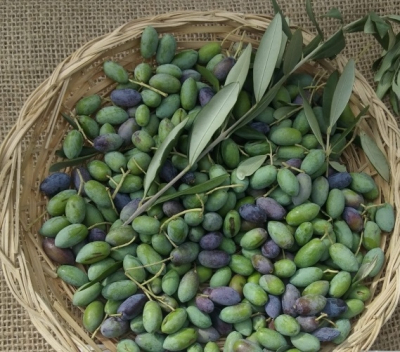
Consumption of olive oil has increased by 82.4% since the 1990/91 crop year. Provisional data for the 2018/19 crop year point to a 4.3% fall, leaving consumption at 2 909 000 t. Estimates for the 2019/20 crop year put consumption above 3 000 000 t.
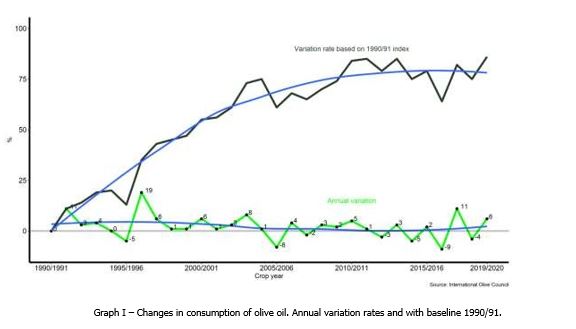
Olive oil – Provisional data 2018/19 crop year and estimates 2019/20
According to official country data and estimates by the Executive Secretariat, global consumption may reach 3 094 000 t in the 2019/20 crop year, an increase of 6.4% on the 2018/19 crop year.
Although data is not final, world consumption is set to reach 2 909 000 t in the 2018/19 crop year, which is 4.3% or 130 000 t less than the previous crop year. Consumption in IOC member countries totaled 2 009 500 t that crop year, a fall of 8%. The total for Europe stands at 1 433 000 t, a fall of 10.2%. Consumption in the rest of Ioc member countries fell by 2.2% to 576 500 t. In the remaining non-Ioc countries, consumption is set to be around 899 500 t, 5.3% up on the previous crop year.
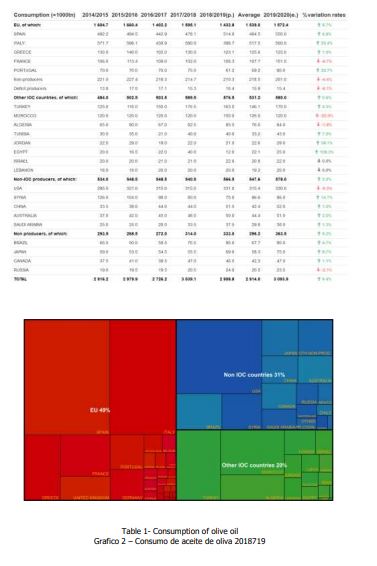
Table olives – Provisional 2018/19 crop year and estimates for 2019/20
The largest increase in consumption was found in the main producer member countries of the IOC. Big boosts to production have led to higher consumption in some countries. Egypt went from consuming 11 000 t in the 1990/91 crop year to 450 000 t in the 2018/19 crop year. Algeria has increased its consumption from 14 000 t to 305 000 t in the same period, and Turkey from 110 000 t to 360 000 t.
Consumption is likely to increase by 2.1% in the 2019/20 crop year.
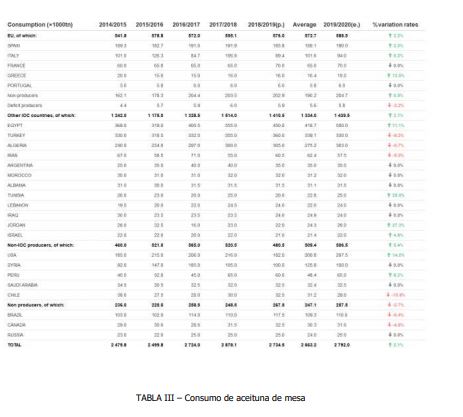
Albania was the highest per capita consumer in 2018 with 10.9kg, followed by Algeria. With a population of 42 million, Algeria consumed a total of 305 000 t, or 7.1kg per person, followed by Egypt with 5.6kg, Turkey with 4.3kg and Lebanon 3.6kg. The remaining countries consumed below 3 kg per capita

Consumption in the Eu rose by 66.2% between 1990/91 and 2018/19, going from 346 500 t in
1990/91 to 576 000 t in 2018/19. Per capita consumption stood at 1.2kg in 2018.
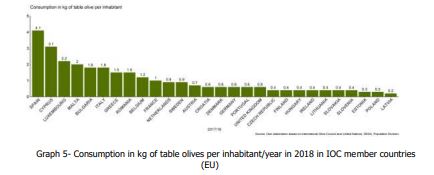
As for non-member countries, Syria leads with an impressive 6.2kg. Peru and Chile are next, with 2kg and 1.6kg respectively, while Australia, Saudi Arabia, Canada, Switzerland, the United States, Iraq and Brazil consumed between 0.5kg and 1kg.
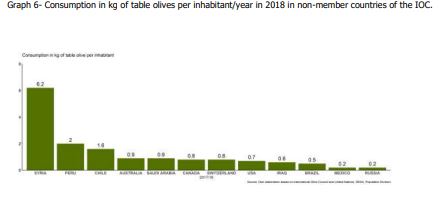
World trade in olive oil and table olives
Olive oil – 2019/20 crop year
The table below shows trade figures for olive oil and olive-pomace oil in the top eight markets in the first month of the current crop year (October 2019). Increases were found in China (+28%) and Brazil (+1%). Imports fell in some non-member countries, such as Australia (-32%); Russia (-7%); the USA (-5%); Japan (-3%); and Canada (-3%).
In the first month of the current crop year (2019/20), extra-EU imports increased by 3% compared to the same period the previous crop year [1].
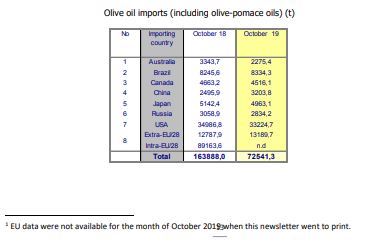
Table olives – 2019/20 crop year
The table below shows trade in table olives in the 2019/20 crop year (September 2019 – October 2019)[2]. Increases were found in the US (+35%) and Brazil (+4%) compared with the same period the previous crop year. However, imports fell by 23% in Australia and 2% in Canada.
In the 2019/20 crop year (September 2019), intra-Eu acquisitions fell by 8% and extra-EU imports increased by 11% compared to the same period the previous crop year [3].
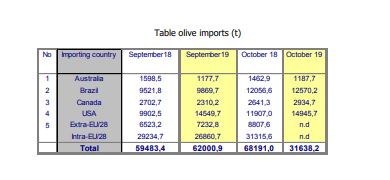
Producer Prices – Olive oils
Graph 1 shows the weekly producer price movements of extra virgin olive oil in the top three producer countries of the Eu and Tunisia. Graph 3 shows the weekly producer price movements of refined olive oil in the top two producer countries of the Eu. Price movements by month can be found in graphs 2 and 4.
Extra Virgin Olive Oil – Producer prices in Spain in the fourth week of December stood at €2.15/kg, a
23% fall compared to the previous crop year (Graph 1).
Italy – Prices in Italy in the second week of December 2019 stood at €3.20/kg, a 46% fall compared to the previous crop year.
Greece – Prices in Greece in the second week of December 2019 stood at €2.35/kg, down 15% on the previous crop year.
Tunisia – Prices in Tunisia were stable in the last weeks of June 2018, coming in at €3.43/kg, an 18% fall compared to the previous crop year.
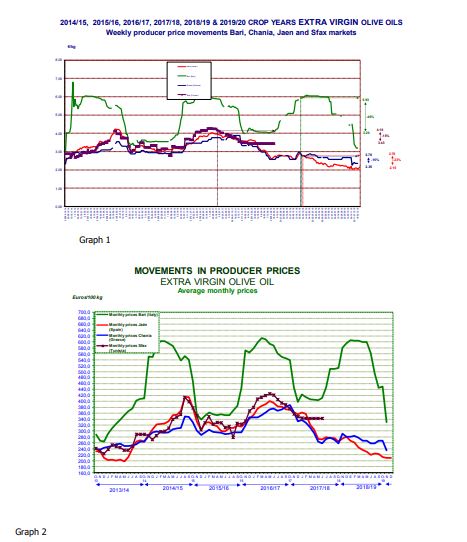
Refined olive oil: Prices in Spain stood at €1.90/kg in the fourth week of December, a fall of 21% compared to the same period the previous crop year. Data for Italy have not been available since late December 2017, when they had risen by 4% to €3.56/kg.
By the fourth week of December 2019, the price difference in Spain between extra virgin olive oil (€2.15/kg) and refined olive oil (€1.90/kg) was €0.25/kg. In Italy, the difference in December 2017 was €0.43/kg (see Graph 3).
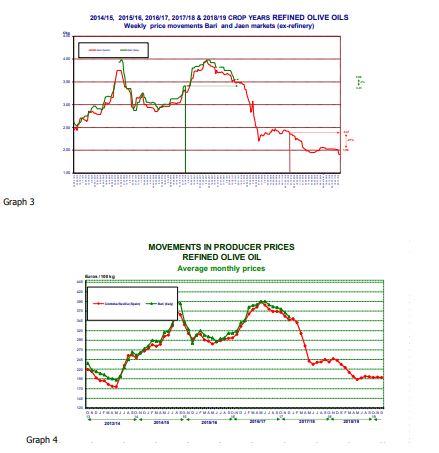
The opening photo is by Fabio Lazzari
To comment you have to register
If you're already registered you can click here to access your account
or click here to create a new account



Comment this news